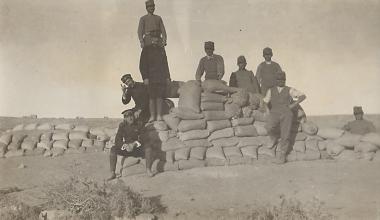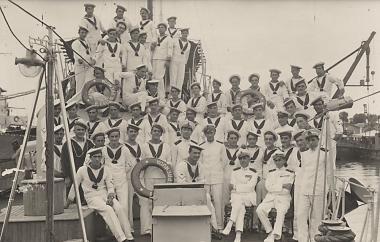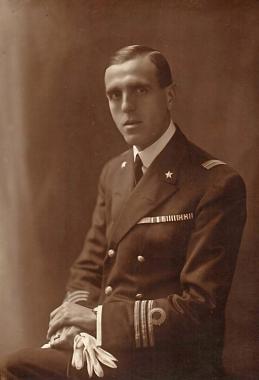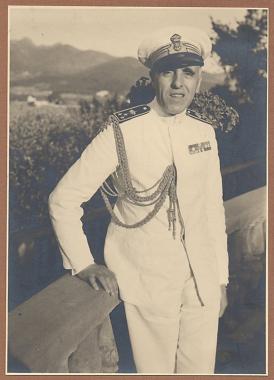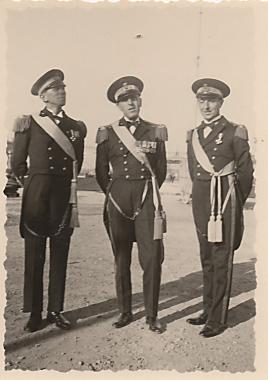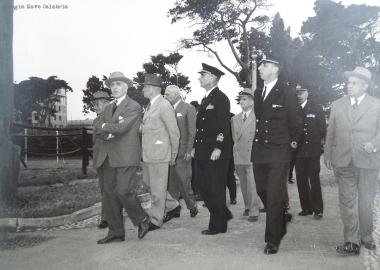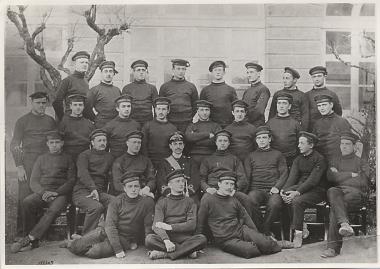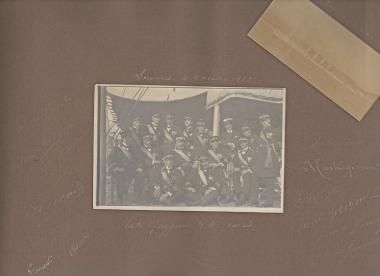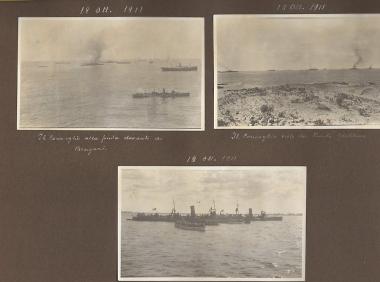The Author
Admiral Carlo Trucco was born in La Spezia on 5th June 1886. On 17th November 1904, after completing secondary school, he attended the course to start his career at the Royal Naval Academy in Livorno. On 5th March 1908, he graduated as Second Lieutenant. His first voyage took place in July 1905 on the Royal Ship Vespucci. As Second Lieutenant, he was immediately called to places which were devastated by the earthquake in Messina in 1908. From 1909 to 1911, he became part of the IV Regiment on the Royal Ship Calabria.
He fought on board the Royal Ship Vittorio Emanuelein the Italo-Turkish War. In July 1913, he travelled to Coatit. We have significant evidence of this particular year, both from his diaries and through the photographic documentation. During the conflict, he was awarded the Bronze Medal for Military Valour. In the First World War, he almost always fought at sea.
On 18th May 1913, at just 27 years old, he was appointed First Commander on the Royal Gunboat Marghera.
On 18th July 1915, the Royal Cruiser Giuseppe Garibaldi , on which he had embarked with the rank of Lieutenant, was torpedoed and sank. by the Austrian submarine "U 4" commanded by Rudolf von Singule, and he was shipwrecked near the Dalmatian coast.
From September 1918 to February 1919 Carlo joined the M.A.S. Trapani Squadron.
In the Spring of 1921 he was called to the Taranto Artillery and Armament Directorate.
On 24th September 1925, following the Royal Assent, Carlo married Marquess Maria Staglieno. January 1928 saw the birth of their son Alessandro, my father, who broke the family sailor tradition and became an officer in the police force.
In Spring 1929, Lieutenant Commander Carlo Trucco accompanied the Royal Family on a cruise on the Savoiaship.
During his time as second-in-command on the Royal Explorer Venezia, a new friendship blossomed with Alberto Da Zara. Their bond endured even in the years following the end of their services. They both experienced the serious events that took place in Asia Minor. Carlo Trucco obtained special praise from the Ministry of the Navy for "the prompt, effective, generous and morally worthwhile work in the name of Italy. His hard work was carried out in light of the serious events in Asia Minor, especially the burning of the city of Izmir - 06/10/1922."
From 1st August 1930 to June 1931, he held the position of Second-in-Command on the Royal Explorer Bari.
From 13th January 1932 to 14th January 1933, he took on the role of Commander of the Royal Explorer Premuda. The same day he disembarked the Royal Explorer Premuda, he immediately became Commander on the Royal Explorer Usodimare.
As well as Commander at sea, he also had various jobs on land. In 1929 he was Head of the Maritime Department in La Spezia.
In 1930, he enrolled at the Navy Institute.
In 1931, he held the post of Vice-Chief of Staff of the High Tyrrhenian Command.
He lead the Naval Base in Venice from February 1935 to June 1937.
In April 1939, he returned to La Spezia as Commander-in-Chief.
On 6th September of the same year, by appointment from the Chief of Staff, he was assigned to the Maritime Military Command in the Elba - Piombino area.
From December 1940 to May 1943, he held the position of Commander at Porto Ferraio on the Island of Elba.
In May 1943, he changed role to Commander in Marina di Fiume. Unfortunately, it was a very short period because he had to, urgently, come back to La Spezia to be admitted to hospital in Marina di Massa. After some time he was discharged and was told to remain on land for the time being.
In June 1942, due to his age, Carlo was ready for retirement. He was recalled to service after a few days owing to the exceptional needs regarding the state of war.
From 9th September 1943 to 30th December 1946, he was considered as "deployed in enemy-occupied territory."
He was, then, promoted to Rear Admiral on 1st January 1945. He retired on 5th June 1950.
Among the many other honours Admiral Carlo Trucco received during his long career in the Navy, and in addition to the Bronze Medal for Military Valour, I vividly recall he was awarded the Commemorative Medal in memory of his service during the Italo-Turkish War. As a result of his service during the First World War from 1915-1918, he was awarded the Distinguished Service Cross and the Inter-Allied Medal of Victory. In 1929, he was awarded Knight of the Crown of Italy and in 1936, Commander of the Crown of Italy. In that same year, he received the Golden Cross for his service. In 1940 he was awarded the Commemorative Medal during the Albania Expedition. During the War Campaign 1940 - 1943 he received the honour of Knight of the Order of San Maurizio and Lazzaro. In 1943 Carlo was appointed Grand Commander of the Crown of Italy.
On 28th June 1950, he finally stopped his service and retired. He retired together with his wife Ange and they resided in La Spezia, where his closest family members lived. Towards the end of his life, he spent his time in the hills above Parma to be near his son, Alessandro and his family. Admiral Carlo Trucco died on 4th December 1974. He was 88 years old. He was buried in the Staglieno family Chapel in the cemetery in Vizzola (Parma).
An excerpt from the diary of Second Lieutenant Carlo Trucco to the Command of the Royal Gunboat Marghera,Ancona, 18th May, 1913.
"My new destination is something of a mystery because on board the Volta ship, no one can tell me at this moment in time where I am destined to be; all that is known is that I must leave as soon as possible. For these reasons, I am exempt from all official visits both on board and to the Commander-in-Chief. I am packing my bags excitedly. It’s my first time into the unknown!
While I am on duty, to my great delight, the ship's Lieutenant came to announce that I must command the gunboat destined to go to Lake Shkodra in Albania.
This is most definitely the best moment of a sailor's life! I believe that if someday, by chance, I were to become Admiral and take on the role of Commander, I would feel just a slight sentiment of pride and joy. The ideal dream for a naval officer is to be a Commander, and to have a ship, albeit a tiny one. That ship must obey his will, and the course of navigation and internal organization is a faithful mirror of his own ability.
But first, one, slowly, needs to get used to the idea. Unfortunately, everyone knows that you can only command a small torpedo boat at around 35 or 36 years old. And so, the youthful enthusiasm fades and gives way to a calmer, more serene outlook. I believe that makes the change to the role of Commander much less satisfying.
In my case, on the other hand, everything unfolded in the best way possible: barely six or seven months ago I became Guard Commander and I have already been called to command the gunboat. Given its highly lagoon-like characteristics, the gunboat will have to make a difficult crossing to a place where there will certainly be no shortage of important and complex missions.
What greater satisfaction could an officer have in his career? I wonder, amazed, in this solemn moment of my sailor existence......"
Allegati













